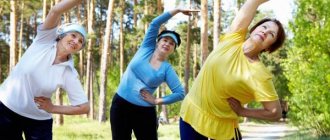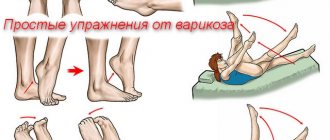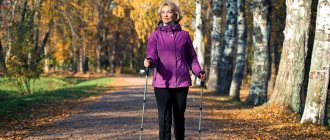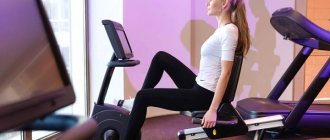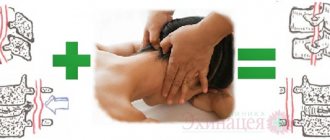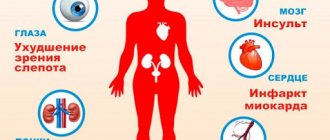Exercise therapy complex for hypotension
For gymnastics to be effective, you must follow simple rules:
- Conduct physical education regularly and systematically. Alternate physical activity, such as dumbbells, and exercises.
- Increase physical activity gradually over a long period of exercise. A minimum of 2 months is required. Don't set the bar high. The increase should be gradual.
As a result of physical exercises:
- Improves blood circulation.
- Stimulates metabolism.
- Supports the body's respiratory system.
Hypotonic patients complain of dizziness and headaches, so it is better to do exercises while lying down.
- Lying on the mat, lift and lower your legs in space.
- Raise your lower limbs in the air, bend your knees and make movements like on a bicycle.
- Raise your lower limbs up and cross them in the air.
- Raise your arms with dumbbells up and down.
- Raise your free arms quickly up and down without dumbbells.
- Bend your lower limbs at the knees, press them to your chest and clasp them with your arms. Now you need to forcefully free yourself from your hands and straighten your lower limbs.
Walking in place is the best exercise for hypotension :
- Start walking in place for two minutes at a slow pace, and then at a fast pace.
- Stretch your arms forward and clench into fists. Walk quickly, while bending and unbending your fists.
- Spread your arms to the sides, walk at a medium rhythm.
- We do a similar exercise with raised arms.
- Place your hands at the waist, raise your legs on your toes, and perform steps in place at an average rhythm for one minute.
- Do the same movement, leaning on your heels.
- Move your body forward, arms at the waist, bend your knees. Move for 15 seconds, half sitting.
- Walk at a slow pace for 30 seconds.
- Walk for two minutes with wide arm swings.
- Swing your left leg forward, backward, right and left, then right.
- Place your feet at shoulder level, gradually lower your arms, touch the floor. We do the same movement with our legs together.
Treatment of hypotension at home
Low blood pressure and exercise
Low blood pressure, or scientifically “ Hypotension ”. This is low blood pressure, which is expressed by low vascular and muscle tone. The term hypotension is also used. People can exercise with low blood pressure. Strength exercises will help cope with this disease. Not only the muscles are trained, but the entire cardiovascular system. Hypotension refers to both chronic constant low blood pressure and sudden temporary decreases. And if a person notices these factors in himself, then the possibility of predisposition to it is high.
Signs of low blood pressure during exercise:
- During strength exercises, you can often feel weak, and fainting is also possible. Very often occurs when training leg muscles.
- The appearance of signs of drowsiness with increasing training time, at the end of the lesson there is a desire to go to bed, yawning appears.
- Feeling dizzy when performing strength exercises, especially when the head is lower than the level of the body. Lying leg curls in a machine, extensions, crunches on a bench, bench press on an incline bench. ⠀
These signs may appear mainly in untrained people. With more training, the body adapts and these symptoms disappear.
The bottom line is that our pressure depends on the width of the blood vessels, as well as the level of glucose in the blood. These factors change when we start training. Under load, blood vessels begin to change, both from aerobic and anaerobic loads. Blood glucose decreases. Its level decreases and so does its pressure. If we take into account that the body is predisposed to this, then together this can give a very serious blow to our body. Even those who have never complained of low blood pressure. This is most often caused by leg exercises. Blood rushes into the legs, and accordingly flows away from the brain and the pressure drops even more.
Factors on which hypotensive training is based:
- When training, you need to have a sweet carbohydrate drink with you. You should drink a sip after each approach. This is necessary to ensure the flow of sugar into the blood.
- It is necessary to do a warm-up. At least for 10 minutes. Warm-up is necessary so that our body is properly prepared for the load.
- It is important to monitor for dizziness. If your head is not dizzy, then you can leave the exercises.
- Legs should be trained at the end of the workout.
- If signs appear that indicate low blood pressure, then you need to eat something sweet.
Learning to breathe correctly
Maintaining a breathing rhythm is an important point during physical exercise.
Correct breathing:
- Through the nose.
- Application of the lower respiratory organs.
- Combining a jerk with an inhalation.
Yoga classes teach you how to breathe correctly. A person can use three types of breathing: upper, middle and lower.
So, what breathing can be used for hypotension:
- Abdominal breathing. In it, we exclude the chest muscles, take a breath, expanding the abdominal area. As you exhale, draw your stomach in as much as possible. Do the exercise 12-15 times.
- Chest breathing. We inhale and expand the chest, while exhaling we release it to the maximum.
- Breathing with the diaphragm. This requires using the diaphragm and chest muscles.
In order to learn rhythmic breathing, you should do the following exercise:
- Inhale for two seconds, exhale for four seconds.
- Add one second to each inhalation, and two seconds to the exhalation.
- We bring the inhalation time to five seconds, and the exhalation will be ten seconds.
Exercise therapy for hypotension with a set of exercises will help eliminate the causes of hypotension. You can add proper nutrition and walks in the fresh air to the complex.
How to exercise correctly
You should draw up a training program together with your doctor. It is necessary to take into account the patient’s condition and the degree of his preparedness.
You should exercise every day. Different types of loads should be alternated. The duration of classes must be at least 2 months. The longer a person trains, the better the effect will be. You need to increase the load gradually. Overvoltage must not be allowed.
For training to bring the desired effect, you need to breathe correctly during gymnastics. Breathing yoga will be useful. You should master various breathing techniques: abdominal, thoracic, diaphragmatic.
For arterial hypotension, physical therapy exercises performed from a lying position are useful:
- The limbs and head should be on the same line; you should immediately raise your head and feet. Hold the body in this position for 5 seconds, then return to the starting position. Repeat 5-7 times.
- Take the same pose. Bend your lower limbs at the knees. Simulate riding a bicycle. You need to go in one direction, and then change it to the opposite. Take a break of 10-20 seconds between changing directions.
- Starting position: lying on your stomach. Lean on your hands. Then do push-ups from the floor. Repeat 4-12 times.
- Stand up straight. Feet shoulder width apart. Run quickly in place. The duration of the exercise is 20 seconds.
- Stand up straight. Grasp the chair with your hand. Sit down. Exhale. As you inhale, rise up. First, you should perform it on both legs at the same time. Then on each one in turn, pulling the second one in front of you. Repeat until tired.
- Walking on your toes is beneficial. Perform for 30-60 minutes.
- Stand up. Spread your legs. Stretch your upper limbs in front of you, holding a stick in your hands. Sit down, exhaling. In this case, the end of the stick should be raised up. While inhaling, return to the starting position. Repeat with the other end of the stick. Repeat 8-10 times. The rhythm should not be too fast.
- You can perform this exercise while sitting on a chair or standing. Take dumbbells. Straighten your arms. As you inhale, raise your upper limbs to the sides. Exhaling, return to the original position. Do 5-10 repetitions.
To perform another set of exercises, you need to take a horizontal position. Lie on your back. Fix your legs. Sit down. The upper limbs should be kept extended at first. After this, you are allowed to move them behind your head. Repeat from 4 to 12 times.
A set of exercises for hypotensive patients
With low blood pressure, physical activity should be moderate. You should start with simple exercises. The load should be increased gradually, focusing on the state of your health.
It is recommended to perform the following set of exercises:
- Walking. At first, you can limit yourself to just this or start studying with it. For the first time, a 5-minute walk is enough, then the time should be gradually increased to half an hour.
- Tilts. This exercise should be done carefully, avoiding sudden movements. You need to lean forward and to the sides. For dizziness, this exercise is contraindicated.
- Push ups. You should start with simplified exercises, push-ups from the wall or on your knees.
- Swing your legs while lying down. You need to raise your straight legs one by one, holding them in this position a little.
- Squats. First, you should use a low chair for exercise, then you can do without it, but keep the body position the same.
- Lunges forward. The back should be straight, and the front knee should be bent at a right angle. In the future, this exercise can be performed with dumbbells.
- Bike. To do this exercise, you need to lie on your back and spin imaginary pedals.
- Scissors. For the legs, this exercise is done in a lying position, for the arms - while standing.
When performing exercises, you should remember about proper breathing. It is useful to practice breathing exercises. During training, you need to breathe through your nose. The rhythm of breathing must be synchronized with the movements - all jerks are made while inhaling.
For hypotensive people, exercises that need to be done lying on the floor are good. This position should also be taken if you feel unwell or dizzy during training. In this case, you need to drink sweet water or tea.
If you have hypotension, the order of exercises must be arranged correctly. You should always start with a warm-up. Leg exercises are done at the end of the workout. Transitions should be made smoothly, warming up before each complex. For the best effect and good health, you need to exercise every day.
The effect of physical activity on blood pressure
During physical activity, blood circulation accelerates sharply, therefore the flow of blood in the vascular system increases. As a result, blood pressure rises. Typically, the higher the load, the more the blood flow accelerates. In a healthy person, this process is important for the normal functioning of the body, if the permissible limits are not exceeded.
Blood pressure may also decrease during exercise, but this condition is considered abnormal and indicates serious health problems.
Cheerful morning: health exercises for hypotensive people
Arterial hypotension is a decrease in blood pressure in men to a level of less than 100/65 mmHg. Art., in women – less than 95/65 mm Hg. Art. Low blood pressure, like high blood pressure, is a fairly common phenomenon: according to various data, it is observed in 30–50% of women (there are significantly fewer hypotensive men).
Circulatory disorders with low blood pressure are less dangerous than with high blood pressure. However, the accompanying conditions (for example, dizziness or loss of strength) are very unpleasant and, in addition, reduce the level of physical and mental performance.
Therapeutic exercises for hypotension
The most effective health remedy for arterial hypotension is “training” of blood vessels. It can and should be carried out in familiar home conditions.
Exercise No. 1 Starting position - lying on the bed, on your back, arms extended above your head, legs together. Stretch, straightening your knees, feet, arms, and tensing. Then relax. Repeat 2-3 times.
Exercise No. 2 Starting position – sitting, hands on knees. Raise your arms, bent at the elbows, one at a time, with tension, until they are fully straightened. Then relax and lower your arms. Repeat 2-4 times. If you feel like yawning while doing an exercise, yawn. This means that your lungs are breathing harder and supplying your blood with oxygen.
Exercise No. 3 Starting position – sitting, hands on knees. Perform circular movements in the shoulder joints with maximum amplitude. Make 5-7 rotational movements forward and the same number back at an average pace. Keep your back straight.
Exercise No. 4 Starting position – sitting, hands on knees, feet shoulder-width apart. As you exhale, grab the knee of your right leg with both hands and slowly, tensing your whole body, carefully pull it towards your chest. As you inhale, return to the starting position. Do the same, grabbing your left knee with your hands. Repeat 2-4 times with each leg.
Exercise No. 5 Starting position – standing, feet shoulder-width apart, arms down. Relax, then tense your abdominal muscles, buttocks, straighten your shoulders, raise your head. Stay in this tense position for 7-10 seconds, then relax again. Repeat 3-5 times. The exercise can be performed by moving around the room to music; When stopping, tense your body muscles.
Blood pressure control after training
Hypotonic patients need to constantly monitor their blood pressure. It is imperative to take measurements before and after training to calculate the changes that have occurred. Based on this result, it is necessary to adjust the duration and intensity of sports activities.
Professionals know that it is optimal to take measurements 20 minutes before training and 10 minutes after it.
It is recommended to monitor indicators during training. It is convenient to use special fitness bracelets for this. They measure not only blood pressure, but also other indicators, such as heart rate and blood oxygen levels.
